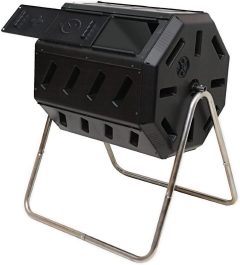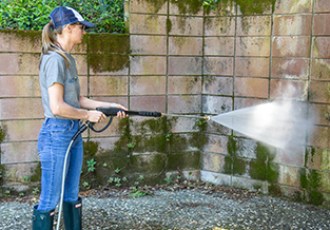BestReviews is reader-supported and may earn an affiliate commission. Details

We chose this garden composter as our top pick for its impressive 43-gallon capacity and reliable construction.
We chose this garden composter as our top pick for its impressive 43-gallon capacity and reliable construction.
Sturdy and durable alloy steel with a rotating design. Two chambers allow you to cook and add fresh organic material simultaneously. Built with adjustable air vents and deep fins to circulate air, break up and decompose clumps in the chamber, and plow oxygen for healthy, finished compost.
A few customers noted the product is difficult to assemble.

One side can be dedicated to active use without interrupting natural processes in the other.
One side can be dedicated to active use without interrupting natural processes in the other.
Tumbling dual-chamber composter with a total capacity of 37 gallons. Separate chambers let you fill 1 chamber while the other is doing its work. Removable door and large openings for easy access. Maximized aeration through holes and deep fins to work through thick pieces.
Some find the individual chambers too small for practical use. Occasional reports of leaks; take extra care to add dry ingredients.

We love that this tumbler-style composter is weatherproof and made of durable materials.
We love that this tumbler-style composter is weatherproof and made of durable materials.
Dual chambers for continuous composting and aerated internal bar for mixing composts and allowing airflow. Designed with double-walled panels for heat absorption. Powder-coated steel frame provides sturdiness and galvanized steel feet prevent rusting and deterioration. BPA-free material.
Some customers noted product is difficult to assemble.

This option is easy to rotate and can bear up to 352 pounds of compost at a time.
This option is easy to rotate and can bear up to 352 pounds of compost at a time.
Features sturdy alloy steel with a steel frame and dual compartments. Designed with air holes for efficient air circulation. Built for easy rotation. Made of PP- and BPA-free material.
A few customers noted assembly instructions are confusing.

Stands out for its spacious, rugged design and superb performance. A solid investment for your garden.
Stands out for its spacious, rugged design and superb performance. A solid investment for your garden.
Galvanized steel construction. Operates smoothly and retains heat for year-round composting. Dual chambers provide 70 gallons of space.
It's pricey, and assembly is time-consuming.

We recommend these products based on an intensive research process that's designed to cut through the noise and find the top products in this space. Guided by experts, we spend hours looking into the factors that matter, to bring you these selections.

Quality compost is a valuable component in creating healthy soil. You can save money and help the environment by making your own compost out of garden waste and kitchen scraps, but to do so, you'll need a garden composter.
If you're new to the world of composting, deciding which composter to get can seem like an impossible task. Bin or tumbler? Metal or plastic? Round or square?

First, let's examine how garden composters work and how you use them:
Once you've situated your garden composter, the first step is to add the organic materials you want to compost.
Now, the bacteria get to work. Microbes break down plant matter and produce carbon dioxide and heat. The center of a compost pile can reach between 100°F and 140°F, at which point heat-loving bacteria get to work and further break down the material.
Bugs, such as worms and slugs, are your friends. They eat and excrete the material in your composter and help turn it into compost more quickly.
Turn your compost every three to seven days to increase the amount of oxygen the material is exposed to and speed up the composting process.
When the material has turned into brown, crumbly compost – which takes between three and 12 months – it's ready to use.




















If you're not 100% sold on the idea yet, here are a few reasons why you should own a garden composter:
Making your own compost is cheaper than buying it.
Composting is environmentally friendly, since you're recycling your own garden waste and certain kitchen scraps rather than sending it to a landfill.
Using compost reduces the need to use controversial chemical fertilizers.
When you compost your garden waste, you don't end up with overflowing trashcans come garbage day.
Compost generally improves soil quality and reduces toxins.
You can find two main varieties of garden composters on the market: compost tumblers and compost bins.
Compost tumblers sit on a frame so you can spin or rotate them to turn the compost inside.
Pros: Quickly and easily turns compost without using a fork, durable sealed construction lasts longer and speeds up the composting process, harder for pests (such as mice and raccoons) to access.
Cons: : Can be pricey, smaller capacity, can be hard to turn when almost full
Price: $100 for basic models; up to $400 for high-end models.

Compost bins look like large square or round vats with open bottoms. The compost sits directly on the soil.
Pros: Large capacity, tend to cost less than compost tumblers, and excess moisture usually drains itself into the ground.
Cons: More work to turn the compost, easier access for pests, compost tends to take longer to be ready.
Price: Anywhere between about $50 and $200, depending on capacity and construction quality.
For most people, home composting is a chore rather than a hobby, so you want a garden composter that's relatively easy to use.
The tumbler is by far the easiest type of composter to use, since you simply have to crank a handle a few times to spin the drum and turn your compost.

Most garden composters are made from either plastic, metal, or wood. Plastic and metal are better choices, as they're better at regulating the heat required for composting.
If you opt for a plastic composter, make sure it's sturdy enough, as flimsy plastics won't stand the test of time.
The capacity of a garden composter dictates how much compost you can make at any one time. Compost tumblers tend to have smaller capacities, usually between 30 and 80 gallons. Compost bins have larger capacities, usually between 60 and 250 gallons.
Unless you have an extremely large garden or routinely peel vegetables to feed an army in the kitchen, something in the range of a 60- to 80-gallon capacity should be more than enough.
Shape isn't too much of an issue with compost tumblers, but if you choose a compost bin, you'll need to get in there with a garden fork to turn your compost.
In this case, it's easier to have a round bin rather than a square one, as unturned compost is more likely to get stuck in the corners.
Take note of these tips for composting success:
Garden composters require some degree of ventilation to help speed up the composting process.
Chopping the material you put in your compost bin into small pieces will help it break down faster.
Try not to let a single material dominate your compost pile. A good mixture is preferable.
Coffee grounds and tea bags (as long as the bags are made from paper) are excellent additions to your compost, so don't just throw them out.
If your compost smells bad, it most likely has too little air and too much moisture in it. Add dry ingredients, such as paper and wood chips, to compensate.
If your compost is too wet, add dry materials such as paper, cardboard, or woodchippings. If it's too dry, add a little water.

Q. What can I put in my garden composter?
A. To create quality compost, you need to put in a roughly even amount of carbon-rich "brown" materials and nitrogen-rich "green" materials. Brown materials include wood prunings, dried leaves, crumpled paper, and pieces of cardboard. Green materials include grass clippings, uncooked fruit and vegetable scraps, green leaves, soft garden clippings, tea bags, and coffee grounds. Avoid putting any animal products (meat, dairy, etc.), cooked foods, leftovers, diseased plants, or animal feces in your garden composter.
Q. How long will it take for my compost to be ready?
A. The answer to this question will vary depending on a range of factors, such as the ratio of nitrogen to carbon, the type of garden composter you have, and how often you turn it. It can take anywhere from three to 12 months for your compost to be ready. Here's some advice from our expert gardening consultant: "Despite advertisements, even the best compost tumblers won’t give you compost in a matter of weeks. For beginners trying to understand how the composting method works, it can take months. And that’s fine, but it’s important to understand that many advertiser claims are exaggerated."
Q. How moist should my compost be?
A. Your compost pile should have a moisture content of about 40% to 60%. Too much or too little moisture affects microbial activity and slows down the composting process. It should feel moist but not wet to the touch – a bit like a wrung-out sponge.
Get emails you’ll love.
Learn about the products you’re wondering if you should buy and get advice on using your latest purchases.
